Trevor Thomas (1907 – 1993)
Trevor Thomas was a multi-talented individual with an engaging and colourful personality. He was Keeper of Ethnology and Shipping at Liverpool Public Museums (1931-40); aged 33 he became the Curator-Director of the Leicester Museum and Art Gallery (1940-46).
Born in Ynsddu, Gwent on June 8th, 1907 into a South Wales colliery family, Trevor Thomas showed a talent for singing as a boy, winning prizes at the Eisteddfods, and he continued to sing through most of his adult life despite being partially deaf.
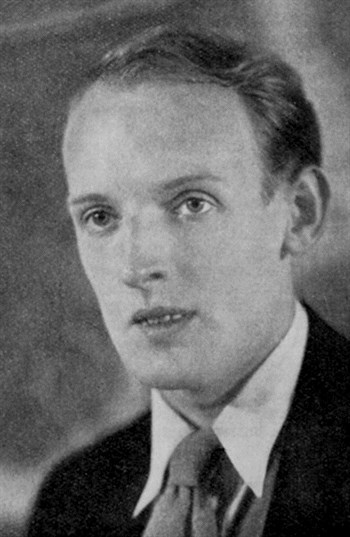 He gained an Honours degree in Human Geography and Anthropology at Aberystwyth. Soon afterwards, aged 24, he became the youngest Keeper to be appointed by the Liverpool Museums, entering the Department of Ethnology and Shipping in 1931.
He gained an Honours degree in Human Geography and Anthropology at Aberystwyth. Soon afterwards, aged 24, he became the youngest Keeper to be appointed by the Liverpool Museums, entering the Department of Ethnology and Shipping in 1931.
Whilst at Liverpool Thomas pioneered new approaches to exhibition design - using bold colour schemes and displaying costume on life-size wood figures he carved himself. He used stacked open-sided cubes and drums as display supports, a forward-thinking approach which attracted praise. He also found time to act and sing, produced theatre designs and collaborated on a production of Murder in the Cathedral with David Webster (later Director of the Royal Opera House, Covent Garden).
American Experience
Thomas’s growing international reputation as a specialist in what was then called ‘tribal art’, helped him win a Rockefeller Foundation Museum Fellowship in 1938-39. He travelled to Buffalo New York to install an African Art exhibition, before further study of US galleries and museums, visiting Texas, New Orleans and the New York World Fair. During this extended visit he saw the latest developments in American museum education and museum display practice, as well as the many innovations in exhibition communication seen in the 1939 New York World Fair. He also developed both considerable knowledge of, and a passion for, some of the latest trends in international, particularly German, French and American, contemporary art, which was to change radically the direction of his future career. Two exhibitions in the then relatively new Museum of Modern Art, New York, were especially influential: the December 1938 to the end of January 1939 contemporary German art exhibition: 'Bauhaus 1919 – 1928', which was soon followed by 'Art of our Time: 10th Anniversary Exhibition' which ran in MOMA from May to September 1939.
Move to Leicester
Thomas re-joined the Liverpool Museums in March 1940 after being found unfit for military service through deafness. In July 1940, following the separating of Leicester’s joint Museums and Libraries Department on the retirement of the long-serving Director, Dr E E Lowe, Trevor Thomas was appointed head of the museums and art gallery, initially with the title of Curator, later upgraded to Director.

After the start of the war New Walk Museum remained open, but with Thomas’ appointment coinciding with the first daylight air raid on Leicester, many objects were moved to the relative safety of country houses away from the City. In 1942 there was even an order to requisition the whole building and clear it for wartime use. After months of limbo, this threat was lifted, leaving the museum needing to provide a service with partially dismantled displays and major shortages of basic materials like paper. Many major museums and galleries remained closed for the duration of the war. However, in London the Director of the National Gallery, Sir Kenneth Clark, re-opened the empty building, and quickly turned it into a major centre of cultural activities, with temporary exhibitions of living artists, educational and social activities, and one of London’s major venues for musical concerts and recitals. The pattern was repeated in towns and cities across the country, including Leicester where Thomas saw the possibility of filling New Walk Museum with just such a programme. He quickly began organising a programme of activities, talks and other educational and artistic activities for all ages, especially in the summer when local authorities were encouraged to organise “Holidays at Home” in order to encourage families to stay in their local area and reduce travel.
He also mounted exhibitions by local artists and arts and crafts groups, and of touring exhibitions circulated by CEMA (the wartime Council for the Encouragement of Music and the Arts of which Clark was a founder and its key influence. CEMA was the predecessor of the post-war Arts Council of Great Britain, now Arts Council England). Following the purchase of an extremely good second-hand grand piano for the Art Gallery/Lecture Hall, in partnership with CEMA he instigated the first Museum’s lunchtime concerts as part of the summer 1943 “Holidays at Home” activities. These quickly became a regular and most popular feature of the New Walk Museum’s winter programme and after the war continued as a permanent annual fixture in the museum calendar, continuing to the present.
German Art
Thomas’s wartime exhibition programme included at least two much more ambitious ones, which gave him the opportunity to present for the first time in the Midlands the latest Continental modern art for which he had become an enthusiast during his time in New York. The first of these was an exhibition of contemporary Polish art, organised in October 1943 with the support of the Polish Air Force of Great Britain. Following the success of this he followed up with the first major exhibition in Britain of German Impressionism and Expressionism, the 1944 ‘Exhibition of Mid-European Art’, in which enterprisingly, and very daringly, Thomas had chosen to show an important selection of 62 works, mainly German artists including Nolde, Marc, Kandinsky, Feininger and Heckel.
At the height of the war such a venture may have seemed almost unthinkable, but the City Council agreed to the plan on the condition that this should not be presented as an official City Museums and Art Gallery exhibition: Thomas was to work on this in his own time, and the exhibition should be sponsored and at least nominally organised by a highly reputable British anti-Nazi cultural organisation, the Leicester Branch of the Free German League of Culture. The League and this venture were quickly supported by a number of leading local public and business figures; including Frederick Attenborough, Principal of the Leicester University College and his wife (parents of Richard and David Attenborough), the prominent barrister Guy Dixon (later Judge Guy Dixon), and art enthusiasts among local industrialists such as Herald Goddard, some of whom were to buy works from the exhibition.
The majority of the artworks had been brought out of Germany by Tekla Hess, émigré widow of the renowned art collector and businessman Alfred Hess, of Erfurt, who had moved to Leicester to be closer to her son, Hans Hess, who was being detailed as an enemy alien in an Internment Camp near Loughborough. The exhibition, and Thomas’s key role in acquiring four works from it as the exhibition closed including Franz Marc’s 1912 oil painting Rote Frau (Red Woman), helped to found Leicester’s renowned collection of 20th century German Art.
For more on this see The Story of the Hess Family.
Start of the Collection
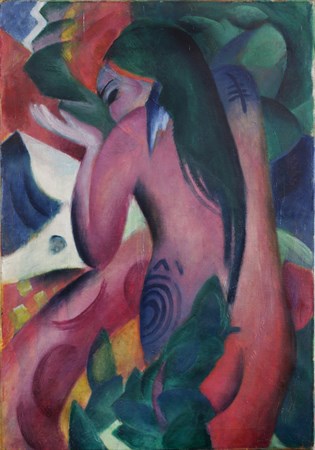
The purchase of Red Woman for £350 by the Museum Committee was an amazing coup for Leicester, and indeed for Trevor Thomas, though it was secured only after a long and difficult debate. In interviews in the 1970s, both the then Museum Committee member Alderman Charles (later Sir Charles) Keene, and Trevor Thomas told Patrick Boylan (Director of Museums and Arts 1972 – 1990) how the meeting proceeded. Thomas as Director recommended the purchase to the Art Gallery Subcommittee, which had the Rote Frau in front of them. At this time the Leicester Literary and Philosophical Society, who had helped set up the museum in 1849, had representatives on the museum committee. These included Frederick Attenborough who argued in favour of the purchase and made a formal proposal it be bought. However, there was both scepticism and outright opposition from some other members of the Committee (including both councillors and at least one other “Lit and Phil” representative). The arguments went round in circles, towards the end of which Thomas declared that he would buy the painting himself if the Committee would not, (though he had no idea how he could pay for it, as he admitted to Boylan more than 30 years later). Sir Charles Keene told Boylan how as meeting Chairman he brought the arguing to a conclusion, by stating:
“We have spent over two hours arguing about £350! The Director is convinced that the Gallery should buy the picture. Surely we can afford £350 to buy a scarlet woman for our bachelor Director?!” As Sir Charles put it, the decision was approved not so much by a show of hands as by peals of laughter!
Dismissal
In July 1946, Trevor Thomas’s career in Leicester came to a sudden end after he appeared in court charged with a public indecency offence. In 1940s Britain, homosexuality was classified as a serious criminal offence and a court appearance for a gay ‘offence’, irrespective of the outcome, would signal almost inevitable dismissal from your job in most areas of life. At that period Leicester was known as a fairly tolerant place where the police generally did not go out of their way to trap and arrest gay men. It was therefore rather surprising that when Thomas went briefly into a public lavatory on Victoria Park by the side of London Road as he walked home from the Museum to Stoneygate he and another man found themselves arrested by a policeman concealed in the building.
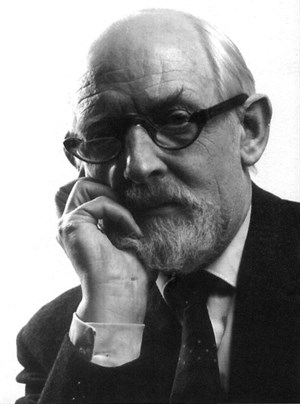 Though such police and Court files are subject to a 75 year closure, Trevor Thomas, as the subject of the case, was allowed to examine his own file in the Leicestershire Record Office in around 1978 in the presence of The Observer’s art critic, Brian Sewell, and Patrick Boylan. The witness report of the arresting policeman admitted that there had been no physical contact or conversation between the two men, but he considered that they briefly “looked towards each other in a suspicious way”. As this was potentially an indictable offence, the case was referred up to the Quarter Sessions. Though confident that no offence had actually taken place, Thomas was advised to plead guilty by his barrister since a ‘not guilty’ plea would open him to cross-examination on oath about his sexual orientation and possible other allegations about his conduct and reputation.
Though such police and Court files are subject to a 75 year closure, Trevor Thomas, as the subject of the case, was allowed to examine his own file in the Leicestershire Record Office in around 1978 in the presence of The Observer’s art critic, Brian Sewell, and Patrick Boylan. The witness report of the arresting policeman admitted that there had been no physical contact or conversation between the two men, but he considered that they briefly “looked towards each other in a suspicious way”. As this was potentially an indictable offence, the case was referred up to the Quarter Sessions. Though confident that no offence had actually taken place, Thomas was advised to plead guilty by his barrister since a ‘not guilty’ plea would open him to cross-examination on oath about his sexual orientation and possible other allegations about his conduct and reputation.
Following a strident denunciation from the Bench, the two men were remanded to prison for four days before being sentenced the following week. On the return to court a number of character testimonials were presented to the Judge: perhaps most significantly Sir Kenneth Clark referred to Thomas’s outstanding achievements and high professional standing, both through his work in Leicester and nationally (where he had been a very influential member of the governing Council of the Museums Association). Clark added that it was widely expected that Thomas would succeed himself as Director of the National Gallery. The decision of the Judge was that despite the guilty pleas the two men should be “bound over to keep the peace” for a period of 12 months in the sum of 12s 6d. Thomas was particularly affronted that he, as a life-long pacifist, was being required by law “to keep the peace”.
Although the verdict technically did not amount to a criminal conviction, Thomas was still dismissed as Director of the Museums and Art Gallery; allegedly receiving a letter from the Town Clerk on the steps of the Town Hall as he left the Court. Throughout his life, Thomas always maintained his innocence of the charge, despite the probably wise tactical move of pleading guilty.
Some years later Trevor Walden, the then Director of Museums and Art Gallery (1953 – 1972), privately asked the Chief Constable of the time why, bearing in mind Leicester’s fairly liberal and tolerant attitude, Trevor Thomas has been deliberately targeted in this way. The former Chief Constable agreed that the whole case had been very regrettable, but is said to have indicated that he felt forced to act because of a number of repeated complaints from an undisclosed source or sources that Thomas was a “known homosexual”. (Information from the late Trevor Walden in an informal interview by Patrick Boylan, 1978).
It is impossible to now know the truth. It may be relevant that while he had many admirers, Thomas also seems to have gathered critics who were less enthusiastic about the direction he was taking the museum. The 1944/45 annual report written by Thomas notes that it was “a year of strange moods and fierce contrast in every way”. This was very much a reflection of the time, with British society torn between a desire to see the coming peace as a time to reform and reorganise and those who wanted a return to the pre-war world. This was perhaps reflected in microcosm within the museum, where Thomas wanted to redecorate and radically reorganise the displays. As the report notes, “the local press carried lively letters against the Museum and its policy as well spirited letters of defence. There were deputations and that well-known symptom, the anonymous letter”.
A Forgotten Man?
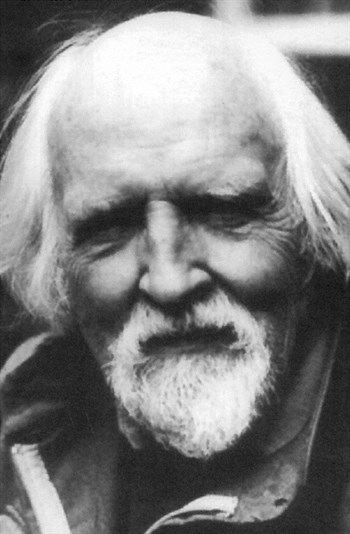
In September 1982 Brian Sewell wrote an article in Art & Artists magazine on the Leicester Expressionist collection. In it he railed against the circumstances of Thomas’s dismissal:
“accused of some homosexual folly in a public loo, Thomas appeared at the Leicester Quarter sessions and pleaded guilty. He was subjected to an abusive tirade from the Bench that would not be tolerated in any court, jugged [jailed] for a week while the judge decided what should be done with him then bound over. He was lucky – in a subsequent case, a young man who had stolen two bars of chocolate and two pairs of silk stockings was jailed for two months…Admitted homosexuality in 1946 was so socially outrageous that the worthies of Leicester felt it necessary to omit all reference to Trevor Thomas after July 1946 and he ceased to exist. Careful examination of the dates establishes beyond all doubt that the foundations of the Museum’s distinguished collection of German art were indeed laid by him with the purchase of its two great pearls, Marc’s Rote Frau [Red Woman] and the Feininger…the Town Clerk’s messenger boy delivered his dismissal notice, and Thomas’s career in Leicester was at an end.”
Was there a deliberate conspiracy to remove Thomas from the record? The affair must have been deeply embarrassing for the council and the museum service, but the evidence for a deliberate removal of Thomas from the record is thin. While no detail is given of the reasons why he left, the museum annual report for 1946 does not omit mention of Trevor Thomas and gives full credit to his achievements in the previous months. Subsequently, over the distance of time, his directorship was perhaps not so much ignored as undervalued, too easily seen as a brief wartime interlude between the much longer service periods of his immediate predecessor and later successors; his main legacy being seen as the lunchtime concerts.
In addition, although the foundations of the Expressionist collection were laid by Thomas, the significance and potential of the early purchases was not necessarily recognised after his departure. Thomas himself makes no mention of the exhibition or the purchases in his own 1944/45 annual report, for example. Although some additions were made in the intervening decades, post-war fine and decorative art collecting policy instead tended to concentrate on more regional interests in British art, English glassware and textiles. It was not until 1975 that the German collection was formally recognised as of prime importance and the museums collecting policy accordingly changed in order to develop it in a serious way.
By this time the details of the 1944 exhibition and purchases were hazy. In this context, it can perhaps be understood how Thomas’s exact role came to be forgotten. In particular, there was an erroneous assumption that the German refugee Hans Hess, whose family were the ultimate source of much of the works shown in the February 1944 Central European art exhibition, and who Thomas had taken on as his art assistant in January of that year, may have been the sole driver behind the first purchases. This was unfortunately committed to print in the foreword to the 1978 exhibition catalogue of the Leicester collection, ‘The Expressionist Revolution in German Art 1871-1933’, which stated:
“The origin of Leicestershire Museums and art galleries’ collection of Expressionist art arose from the appointment of the late Hans Hess as the Museum’s Assistant Keeper of Art in 1944."
Publication of this misleading summary prompted an understandable reaction, leading to more research to uncover the true role of Trevor Thomas. On examination of the record, it became clear that Hans Hess, despite his family connections, did not lead the organisation of the initial exhibition or subsequently add any further artworks to the fledgling Expressionist collection during his time at Leicester as Art Assistant and later Keeper of Art.
With this new information, the Director of what by now was the Leicestershire Museums Service, Patrick Boylan, worked hard to set the record straight. In 1985 he updated the 1978 Catalogue, The Expressionist Revolution in German Art, 1871-1933, with a detailed explanatory erratum:
“Although all the commentaries from the early 1950s onwards attribute the origin of…the collection to the appointment of the late Hans Hess in the spring of 1944, this was not in fact the case… The credit for this far sighted, indeed audacious, bearing in mind the wartime conditions, move must go entirely to Trevor Thomas and those members of the Museums and Libraries Committee who were prepared to back their Director’s judgment.”
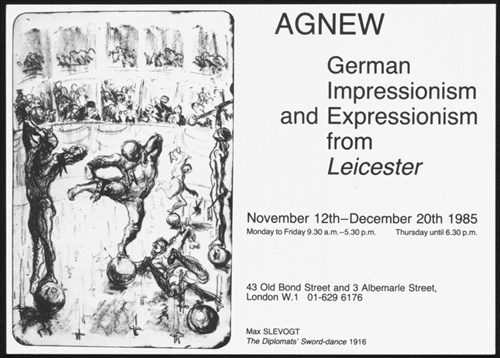 In the catalogue introduction to the 1985 exhibition at Agnew’s, London of German Impressionism and Expressionism from Leicester, Dr Boylan also stated:
In the catalogue introduction to the 1985 exhibition at Agnew’s, London of German Impressionism and Expressionism from Leicester, Dr Boylan also stated:
“The credit for both the (1944) exhibition and the first purchases must be given to Prof. Trevor Thomas, who is happily still alive and well today.”
On 19th November 1985 at a reception at the New Walk Museum, marking the centenary of the building of the Art Gallery, Trevor Thomas attended as an honoured guest, an important milestone in the public reinstatement of his reputation and achievements at Leicester.
Whilst the gesture could never undo the fierce injustice of the past, it was greatly appreciated by Thomas and helped the reconciliation process.
Career after Leicester
To the end of his life Thomas believed that his summary dismissal from Leicester ruined his professional museum career. However, he made very considerable contributions in several other places and fields. Very soon after leaving Leicester Thomas was appointed to the staff of the recently formed the Arts Council (chaired by Sir Kenneth Clark), serving as Regional Surveyor of Pictures from 1946-48, and also directing the Craft Centre through 1947. The same year under medical pressure on how to “cure his homosexuality” he made a disastrous and short-lived marriage. In 1949 he moved to Paris to join UNESCO (the United Nations Educational, Scientific and Cultural Organisation) as Programme Specialist in Education, and over the following six years made important contributions to the promotion of the latest approaches to education in the arts around the world.
In 1956 he moved to the USA, first as Visiting Professor at Columbia University in New York, after which he moved to upper New York State as of Professor of Art History at Buffalo University, at a time when the cutting edge of world contemporary art was moving rapidly from Paris and London to New York. He told Patrick Boylan that these four years were among the most personally rewarding and fulfilling time of his life, other than his period in Leicester, allowing him to expand his theatre and music interests, directing and performing in both drama and opera productions and often doing the set and costume design as well. During this period he also developed his own painting and drawing practice and held a number of exhibitions. His own painting was influenced by the American Abstract Expressionists of the period, though in retirement he developed a new technique with flowing and swirling colours, giving vivid impressions of dance and movement.
In 1960 he returned to England and was appointed Art Director to the Gordon Fraser Gallery greeting cards company based in Bedford, editing their well-known range of postcards and fine arts greetings cards until his retirement in 1972.
Return to England
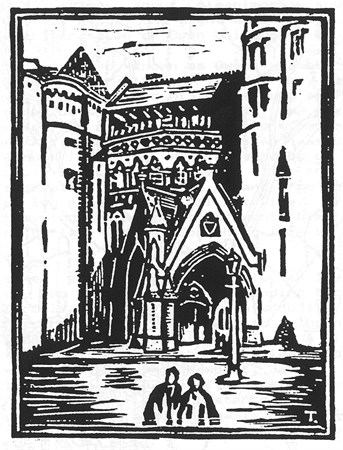
On his return to England he lived first in London. His obituary notice in the Independent, 9 July 1993, also included his time living at 23, Fitzroy Road, London:
‘…where Sylvia Plath, separated from her husband the poet Ted Hughes, lived above with her two very young children. Thomas was the last to see her the night she committed suicide by gassing herself in 1963, and was poisoned himself by the gas coming under pressure down the chimney.
Subsequently Thomas made his home in Bedford where he lived for over 28 years, the last 13 with his close friend Robert. He continued his work with the Gordon Fraser gallery. Trevor Thomas’s first work with the Campaign for Homosexual Equality was in the 1970s. At a CHE conference in 1975 he went to the aid of a young man who had become distressed whilst on stage. Thomas stepped onto the rostrum, put his arm round the young man’s shoulder and at last related publicly his own story. Perhaps in the process Thomas was also coming to terms with what had happened to him. From 1976-1982 he was a member of CHE’s executive committee.
In the words of his close friend Robert:
‘Thomas was passionately against capital punishment and worked vigorously to counteract social injustice wherever possible. Triumphing over personal disabilities, he was abundant in friendship, warmth and energy, greatly enjoying his many friendships, classical music, cooking and his flowers. He possessed an extraordinary memory that enabled him to recall and visualise past events in accurate detail. He was a man of impressive talents and integrity.’
Trevor Thomas obituary in The Independent, Fri 9 July 1993
Trevor Thomas, art historian and artist: born Ynysddu, Gwent 8 June 1907; Secretary and Lecturer-Assistant, Department of Geography, Victoria University, Manchester 1930-31; Cartographer to Geographical Association, Manchester 1930-31; Keeper, Department of Ethnology and Shipping, Liverpool Public Museums 1931-40; Director, Leicester Museum and Art Gallery 1940-46; Surveyor, Regional Guide to Works of Art, Arts Council of Great Britain 1946-48; Director, Crafts Centre of Great Britain 1947- 48; Programme Specialist for Education through the Arts,UNESCO 1949-56; Professor of Art, State University of New York, College for Teachers, Buffalo 1957-58; Professor of Art History, University of Buffalo, 1959-60; Art Editor, Gordon Fraser Gallery 1960-72; married 1947 (two sons; marriage dissolved); died Bedford 27 May 1993.
TREVOR THOMAS was a man of multiple artistic talents with a sparkling personality, flamboyant, eccentric, friendly, a raconteur extraordinaire. He was also the last person to see the poet Sylvia Plath alive.
